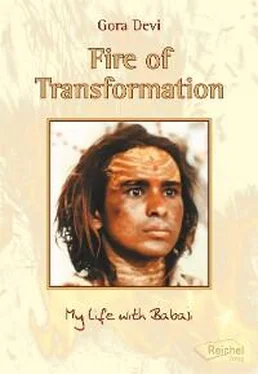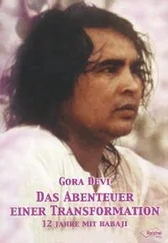Although he has chosen to always be in this world, in order to help it, normally Babaji resides behind the scenes, seen and recognised by only a few. It is said that he, as Mahavatar, materialises his body directly when needed and is not born physically of any woman. Normally he maintains his youthfulness even whilst embodied, appearing as the ever-young and beautiful youth; but this is clearly not always the case, as Babaji can do whatever he pleases and sometimes he chooses otherwise. He has appeared young, old, thin, fat, in sequence or simultaneously, in one body or several, to various people. Likewise, as Mahavatar he is said to be immortal even in his physical form or forms, yet this cannot be understood in the ordinary way: death is not always what it seems. Babaji plays a divine drama. He plays with elements. He can appear where and when he wishes, in one or more bodies simultaneously, physical or subtle, and of whatever appearance and age he chooses, and can dissolve them into light or otherwise as and when he decides.
In his last public manifestation - the one in which Gora Devi was involved and which is the subject of this book - Babaji was referred to as the '1008 Baba'. In this he had an exquisitely beautiful form, but one which he continually changed during the fourteen years of his public appearance. The public manifestation previous to that one (1800-1922), which was referred to by Paramahansa Yogananda in his widely distributed and influential book, The Autobiography of a Yogi, was as the '108 Baba'. Both manifestations were as the Hairakhan Baba, for Babaji chose Hairakhan as his place of manifestation, for a specific purpose.
Hairakhan (a name derived from Hiriya Khand, meaning 'sanctified area') is a place close to and including a tiny, remote village in the Nainital District of Uttar Pradesh, in the Himalayan foothills of India, twenty-six kilometres east of the market town of Haldwani. The village lies on the bank of the holy river Guatama Ganga, opposite a sacred cave that lies at the foot of the Kumaon Mount Kailash. This mountain is the original Kailash, the physical representation of Mount Meru, the sacred mountain marking the central axis or heart of the world and home of Lord Shiva. It was much more recently in human history that the second Mount Kailash (i.e. the Tibetan Mount Kailash) was 'found' further north in the higher peaks of the Himalayas, on the northern side of Lake Mansarovar, as a kind of substitute for the original. The Guatama Ganga flows underground from Lake Mansarovar and surfaces not far from Hairakhan. The sacred cave, like the Kumaon Mount Kailash, is said to date back to the time of creation, and is described in the Shiva Puranas as a dwelling place of the Gods and the place where Shiva (or Babaji) periodically retreats for meditation and tapasya (ascetic practices).
As '108 Baba', Babaji appeared in about the year 1800 to Hairakhan villagers as a bright light on top of the Kumaon Mount Kailash. Eventually the Mahavatar emerged from this light as a beautiful youth, condensing his body out of the dazzling light. Having stayed at Hairakhan for a few years he then travelled around the Kumaon region, gathering to himself certain devotees and disciples, great saints and yogis, and at times crowds of people came to celebrate festivals with him. In the 1840's he constructed with his own hands and the help of the villagers an octagonal temple (representing Shiva's eightfold manifest power) on a small hill opposite to and on the other side of the river from the Kailash cave. Besides being at Hairakhan, Babaji was seen by many people in different places, and performed many miracles through the power of his love. Having promised to return again, in August 1922 Babaji went with some of his devotees to the confluence of the Kali and Gauri rivers and, stepping into and then sitting on the surface of the water, he dematerialised into a ball of light in front of their eyes and 'disappeared'. In the following years, however, he appeared to many of his close devotees in dreams, visions or even direct physical form.
The great saint and sidha-yogi, Mahendra Baba, who spent his life searching for and preparing for the return of Babaji, was one of those to whom Babaji appeared physically. Babaji gave him certain signs and a unique, secret mantra by which he, Babaji, could be recognised when he next appeared publicly. Mahendra Baba passed on this knowledge to his disciple, Shri Vishnu Datt Shastriji, who duly recognised and confirmed the reality of Babaji in the Mahavatar's next public appearance. Shastriji subsequently became Babaji's 'priest'. Mahendra Baba also foretold the year, 1970, when Babaji would make his appearance, and prepared the world for this event through his writings, teachings and building of ashrams.
In June 1970 Babaji was duly 'discovered' in the sacred cave at the foot of the Kumaon Mount Kailash. Gradually he drew to himself more and more people, to visit him at Hairakhan, to undergo purification and training under his guidance, and to build an ashram and further temples. After fourteen years of extraordinary activity and demonstrations of divine love, and having foretold the date of the event, he underwent mahasamadhi.
It is said that we all need a guru to help us achieve liberation from mortal attachments and impurity of living, and thus to realise the Divine. Guru means 'the remover of darkness'. Sometimes the guru is seen, sometimes not seen. Sometimes he is physically present, sometimes not. Sometimes he is male, sometimes female. At all times he is within us, as we are each part of the Divine, and likewise we are always within the Guru. But we have to gradually realise this and what it means. Several of my friends and acquaintances met the 1008 Hairakhan Babaji in his physical form, and Gora Devi was one of them. I did not do so: I met the Great Master in another way, and he guides me still. I did not have to undergo the huge shock and lesson of detachment from the Master's physical presence when he left his body in 1984 - which is one of the final things that disciples have to learn - but Gora Devi did. This story of hers is a wonderful story of courage and devotion, and of love shared between two friends, one divine and the other human.
Peter Dawkins
Roses Farmhouse
January 2002
I first met Gora many years ago, a humble and unassuming person, peaceful yet with a quiet strength. In time I discovered other facets; a very animated person with a playful sense of humour, determined and sincerely dedicated to God. Out of this contact and friendship came the opportunity to be involved with the production of this book. If I had any doubts, they dissolved after reading the text. It is remarkable in its honesty, beauty and intimacy, appearing almost childlike in its innocence; a woman's search for identity and for love, and through her encounter with Babaji and his continuing presence her heart opens to the flowering of divine love.
Gora's diary is as much a mystical journey as it is a distinctly human story, in which simple everyday events are interwoven with a divine presence that is extraordinary, infinite and mesmerizing, where the tangible is entwined with the intangible. Alongside immeasurable joy there also exists pain, hardships and continual challenge. At times her story is provocative, difficult to understand or accept, sometimes it all appears like a magical fairytale, at other times a heavenly utopia or bizarre drama, yet within the humanity of the events there are echoes in all of our lives, within the words an energy that subtly finds its way to the heart of the reader. The presence of Babaji, felt if not completely understood, increasingly pervades the text and transports meaning beyond the words on the page.
A number of years passed before Gora considered writing this book, before realizing that the period of time spent with Babaji had also been a preparation for the role of author as well. She recalled that it had been Babaji who, in so many ways, had encouraged her to keep her diary, and when initially asked if she would write her story she replied, 'When Baba tells me to...' The original Italian version was finally published in 1993 and is updated in this English edition by the inclusion of an extra chapter both at the beginning and at the end.
Читать дальше











